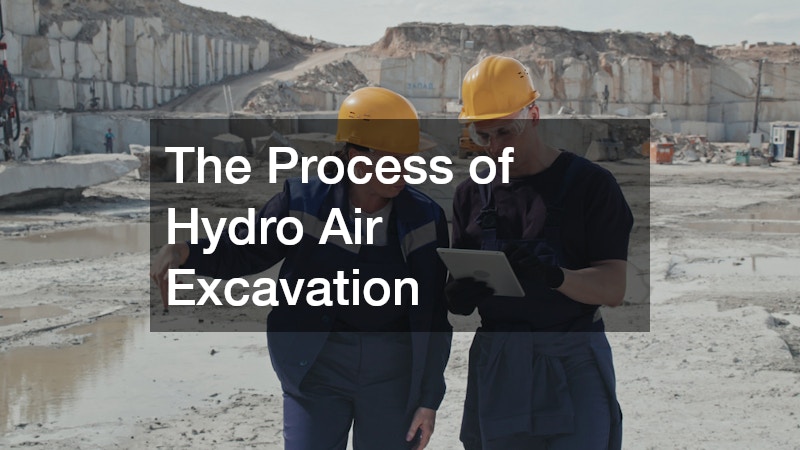How Does a Hydro Air Excavation Service Get the Job Done?
Hydro air excavation service is an innovative approach that combines the powers of water and air to safely dig and excavate the ground. This method is widely used in various industries such as construction, telecommunications, and utility maintenance. Its primary advantage lies in its ability to excavate soil with minimal environmental disruption and risk.
Traditional excavation methods often lead to collateral damage, whereas hydro air excavation is precise and controlled. By using a high-pressure water jet and an industrial-strength vacuum, this service can efficiently uncover underground utilities without causing harm or unnecessary disturbances.
The components of a hydro air excavation service typically include a specialized truck equipped with a water tank, air compressor, and vacuum system. The water jet loosens the soil, while the compressed air aids in breaking it up further, and the vacuum system then clears the debris. This setup ensures that the process is streamlined and effective, making it an essential service for urban areas where utilities are densely packed underground. Additionally, the use of water reduces dust, improving visibility and safety for workers. This level of precision is essential for projects requiring care and accuracy, particularly when dealing with delicate or complex utility layouts.
Performance and safety are at the heart of hydro air excavation services. Unlike traditional mechanical methods, which carry a higher risk of damaging underground installations, this method provides a non-destructive alternative. It can handle a range of soil types and conditions, making it suitable for both urban and rural applications. Using water and air also minimizes the potential for hitting buried lines or cables, significantly reducing the risk of costly damage or service interruptions. This makes hydro air excavation a preferred choice for projects that require meticulous attention to safety and detail.
The Process of Hydro Air Excavation

The hydro air excavation process begins with site preparation, which involves setting up the equipment and marking out the area to be excavated. Safety is a critical concern, so thorough surveying and planning are conducted to identify existing underground utilities. Once preparation is complete, high-pressure water jets are used to break up the soil around the target area. The water jet, controlled with precision, ensures that the soil is sufficiently loosened without disturbing the surrounding areas. Simultaneously, an air vacuum system sucks up the displaced soil and water, leaving a clean and clear space ready for further work.
The multi-step process continues with material separation, whereby the vacuum system separates water from soil, facilitating easier disposal and recycling. This aspect of the hydro air excavation service is environmentally friendly, as it allows for the re-use of materials and reduces landfill waste. Furthermore, the use of high-capacity vacuum systems ensures quick and efficient removal of debris, resulting in faster project completion times. This efficiency is particularly beneficial in urban projects where minimizing disruption and downtime is critical. The flexibility and adaptability of the process allow service providers to tailor their methods to the specific requirements of each project.
On completion of the excavation, the site is often evaluated to ensure that the dig has been carried out according to the required standards and specifications. Hydro air excavation service involves constant assessment and monitoring, ensuring that any potential issues are immediately addressed. Specialists often document the entire process, which aids in maintaining compliance with regulatory standards and provides assurance to clients. The precision and safety of this technology have made it an indispensable tool across industries dealing with underground facilities. Its adoption continues to grow as more industries recognize its benefits in terms of safety, accuracy, and efficiency.
Advantages and Applications of Hydro Air Excavation
Using a hydro air excavation service has several advantages over traditional excavation techniques. One of the main benefits is the reduced risk of damage to underground utilities, which are often costly and time-consuming to repair. The precision of water and air allows for careful displacement of soil surrounding utilities such as gas lines, electrical cables, and water mains. This offers peace of mind to both service providers and clients, knowing that the excavation is conducted with minimal risk. Moreover, the technology reduces the environmental impact of excavation, making it a more sustainable option.
Another key advantage of hydro air excavation is its versatility across different applications. It’s widely used in municipal projects for the installation and maintenance of utilities, as well as in landscaping and construction projects. The method is particularly useful in areas with complex underground infrastructures, where traditional digging might pose a significant risk. Additionally, the process is often faster and more cost-effective, as it requires less manpower and can be completed in a shorter timeframe. These attributes make hydro air excavation an attractive option for projects where speed and precision are critical.
The efficiency and safety of the hydro air excavation service make it ideal for emergency situations, such as responding to utility outages or accidental damage. Its ability to quickly and accurately locate and expose buried lines is crucial during repairs, minimizing downtime and restoring services swiftly. In industries where rapid response is often necessary, such as telecommunications or utilities, this method provides a dependable solution. With advancements in technology, the capabilities of hydro air excavation continue to evolve, further cementing its role as a vital service in modern infrastructure management. This ongoing development ensures that the service remains at the forefront of excavation technology, consistently meeting new challenges and demands.


